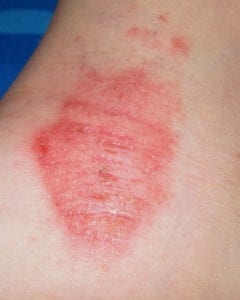Eczema is a skin condition that not only creates a very bothersome rash, but can even become resistant to antibiotics and transform into deadly MRSA (methicillin resistant Staphylococcus aureus).
But in breakthrough research published in Science Translational Medicine, scientists report what appears to be a highly effective treatment and even a possible cure for the diseases caused by S. aureus.

For the first time, researchers from University of California San Diego learned that those affected by atopic dermatitis tend to have less of certain types of bacteria on their skin. The human skin is loaded with bacteria considered good and bad, but in most people it creates a symbiotic environment that is not harmful.
“We discovered antimicrobial peptides produced by bacteria commonly found on healthy human skin,” Teruaki Nakatsuji, a Dermatology professor at UCSD, reported in a news release. “These novel antimicrobials have selective activity against pathogenic bacteria, but do not harm other commensal bacteria that have a beneficial effect to us.”
Related: Smartphone Add-On Camera Lets You See Beneath the Surface of Your Skin
The scientists first tested their theory on animals. Although the human trial only involved five patients and was intended to test only for safety, all the patients showed remarkable results. “Autologous bacterial transplant in a small number of atopic dermatitis patients drastically reduced S. aureus skin burden,” according to the paper’s abstract. “This commercial skin transplant is already approved by the U.S. Food and Drug Administration, with a (Phase II) clinical trial underway.”

The National Eczema Association reports that about 18 million Americans have atopic dermatitis, usually in the form of eczema. It can break out on the arms, legs and cheeks. It’s bright red and it itches, creating great discomfort among those affected.
“After isolating the good bacteria and growing it, we were able to transplant it back to people who were deficient in it and it had an immediate impact by reducing the amount of S. aureus on the skin,” said Dr. Richard Gallo, chair of the Department of Dermatology at UCSD. “We now have a rational therapeutic approach for atopic dermatitis by using bacterial transplant technology. It appears that people with this disorder will need to have it reapplied because their body does not naturally promote the growth of these organisms. The good thing is this is easy to do because it’s just a cream.”
Related: Acne-Causing Bacteria Might Also Fight Skin Disease
Nakatsuji explained this “natural antibiotic” is superior to pharmaceutical approaches because it doesn’t kill the protective bacteria on the skin. “Antibiotic resistance is not likely to occur because the bacteria therapy is attacking pathogens by multiple different ways at once.”
Per the National Eczema Association, atopic dermatitis first appears in childhood, usually in the first six months of life. In some people, it disappears with age, but others experience severe flare-ups well into adulthood.
A professional journalist nearly 30 years, David Heitz started his career at the Quad-City Times in Davenport, Iowa before moving to Los Angeles. He led the Glendale News-Press to best small daily newspaper in the state (CNPA) as managing editor and also worked as executive news editor of the Press-Telegram. He worked briefly as deputy news editor of the Detroit News before returning to the Quad-Cities, where he has worked as a freelance medical writer since 2012 for several national websites. He recently purchased his childhood home and says he truly is “living the dream.”


![How To: ‘Fix’ Crepey Skin [Watch]](https://cdn.vitalupdates.com/wp-content/uploads/2017/05/bhmdad.png)












